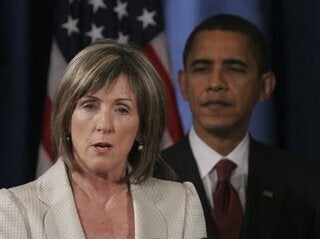
Barack Obama's final appointments in December indicate a strong commitment to action on climate change. Steven Chu as Energy Secretary, Carol Browner as Energy & Climate Czar, John Holdren as Assistant for Science and Technology -- just to name a few recent selections -- are all proponents of vigorous action to cut U.S. global warming pollution and take leadership on a new international climate treaty. And Hilda Solis, Obama's new Labor Secretary, is a champion of "green jobs."
All is well on the climate front, it seems. Except that it's not.
Carbon cap and trade regulation remains the top federal policy priority for the majority of environmental groups. But in June, cap and trade legislation failed in the Senate, and sixteen Democratic Senators from coal and manufacturing-heavy states voiced their opposition to high carbon pricing. The policy faces even greater obstacles in today's economic climate, since it would increase the energy bills of the American public.
Despite Obama's appointments, climate advocates are thus left to worry: is Obama really prepared to expend his political capital championing a policy that will increase U.S. energy prices in the midst of a recession?
Not likely. Until recently Obama voiced support for carbon regulation, declaring at a governors' climate conference in mid-November that his climate agenda "will start with a federal cap and trade system." But since then, as the recession has deepened, he has said little to nothing about cap and trade. His apparent change of heart may reflect a larger global trend, with European nations increasingly voicing opposition to their Emissions Trading Scheme and Canadians rejecting the Liberal Party's proposed carbon tax in their October election.
Does Obama have an alternative climate strategy? So far, he appears to be wrapping his climate policy into a "green stimulus" plan, focusing on public investments to create "green jobs" in the construction of energy efficient infrastructure. He has even mentioned some investment to build renewable power plants. But the large majority of the stimulus seems set to go toward short-term investments that will quickly create jobs -- retrofitting buildings and constructing traditional infrastructure projects like highways and bridges.
Replacing sustained climate legislation with a short-term "green stimulus" program to create green jobs and perform energy efficiency retrofits is a dangerous possibility. Increased energy efficiency can only satisfy a portion of the necessary reductions in global warming emissions, and it will not help develop and deploy the low-carbon energy technologies that are essential to transform U.S. and global energy systems. Yet with green jobs now positioned as "the solution" to both the economy and the climate, Obama has cover to take the politically expedient route of short-term green stimulus while ignoring serious climate policy.
Avoiding this outcome demands a shift from green jobs to a broader focus on green technology. The single greatest obstacle to creating a "green energy economy" is the high cost of low-carbon energy technology. Technologies like solar photovoltaics, plug-in hybrids, and advanced geothermal are all more expensive than their conventional market competitors.
A serious alternative to cap and trade would therefore focus on making clean energy cheap, prioritizing major, sustained public investments to drive down the price of green technologies as quickly as possible. This would require federal investments on the scale of $500 billion over the next decade to support and accelerate each stage of the energy innovation pipeline: research, development, demonstration, and deployment.
Obama has made it increasingly clear that public investment is his preferred climate policy mechanism. What Obama has not made clear is whether or not he will embrace the type and scale of investments necessary to seriously confront the climate challenge.
If cap and trade is a no-go in today's economic climate, Obama must redouble his commitment to public investment in clean energy, investing at least $500 billion in green technology over the next ten years. And while cap and trade may still be the preferred policy mechanism of most environmental groups, new political circumstances demand new tactics. Public investments in green technology are clearly more viable, and climate advocates should embrace them, while remaining vigilant that Obama's climate agenda does not stop with efficiency and green jobs.
The prosperity and security of the United States in the 21st century will depend largely on the course of action set by the nation's new leadership. The scale of our climate challenge is great, and so is the scale of public investment needed to overcome it. The Obama administration and 111th Congress must seize the moment not only to stimulate short-term economic recovery and job creation, but also the long-term technology innovation and deployment that will make clean energy cheap and secure our nation's energy and climate future.
--
Teryn Norris and Jesse Jenkins are Project Director and Director of Energy & Climate Policy, respectively, at the Breakthrough Institute, and co-authors of the National Energy Education Act proposal.

